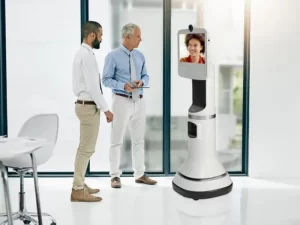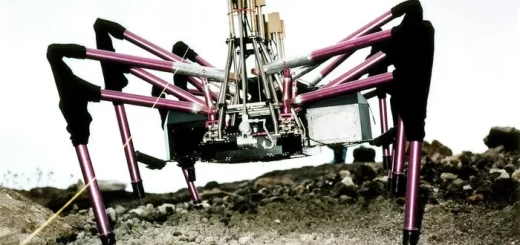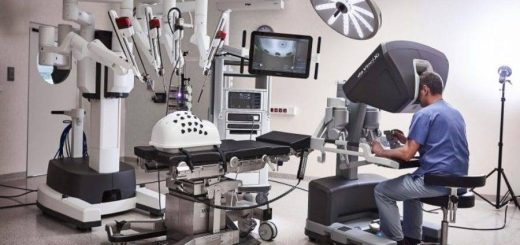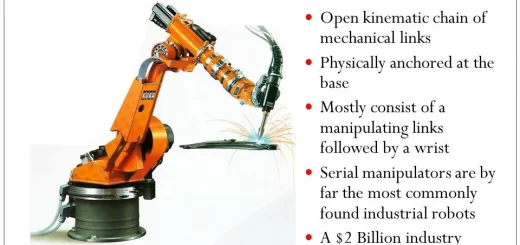RP-VITA telemedicine robot review, features, advantages and disadvantages
RP-VITA is equipped with high-definition cameras and microphones, It acts as a doctor’s eyes and ears in remote locations. The doctor using the robot can see and hear everything around the patient, making examinations and consultations almost as good as being there in person. RP-VITA navigates the human world, standing tall like a friendly helper.
RP-VITA telemedicine robot
RP-VITA Telemedicine Robot is a robot developed by the company VITA Robotics that allows doctors to remotely examine and interact with patients. It is a Robot Doctor with Superpowers, It is no ordinary robot, It’s a cutting-edge telemedicine marvel that brings healthcare directly to patients, in remote areas or for those with limited mobility. RP-VITA is equipped with AI smarts that help it avoid obstacles, navigate complex environments, and follow pre-programmed routes within a hospital or patient’s home.
RP-VITA‘s name is a clever play on words. “RP” stands for “Remote Presence,” while “VITA” means “life” in Latin. So, it’s a “remote presence of life,” bringing healthcare closer to those who need it most. Forget bulky medical equipment; RP-VITA has a built-in digital stethoscope! This allows the doctor to listen to the patient’s heart and lungs remotely, providing valuable diagnostic information.
Video conferencing is great, but RP-VITA takes it a step further. The robot has a handy arm that can be equipped with various tools, letting the doctor take vitals, check reflexes, and perform basic examinations. RP-VITA isn’t just about convenience; it’s about bringing healthcare to those who need it most. Patients in remote areas, those with disabilities, or those facing isolation can receive quality care thanks to this technological marvel.
While RP-VITA shines in healthcare settings, its potential extends beyond hospitals. Imagine using it for education, providing remote assistance in dangerous situations, or just staying connected with loved ones who live far away. RP-VITA isn’t just a head-on stick. It’s a complete mobile unit with a high-definition screen, a microphone and speakers for clear communication, and a built-in examination table!
This robot doctor has tools to see, hear, and feel. It uses advanced cameras to navigate and examine patients, It has a built-in stethoscope for listening to heart and lung sounds and can measure temperature and blood pressure. Through secure video conferencing, RP-VITA connects patients with specialists miles away. So, you could be in a rural village and still consult a top cardiologist in a big city!
RP-VITA isn’t just for video calls. It can connect to various medical devices like ultrasound machines and otoscopes, allowing doctors to perform remote examinations and get a more complete picture of a patient’s health. RP-VITA glides around on a sturdy base with six wheels, navigating tight spaces and climbing low inclines with ease.
The robot‘s detachable “head” houses a high-definition camera, microphone, and speakers, allowing remote doctors to see, hear, and talk to patients just like they were in the same room. RP-VITA isn’t just a pretty face (or, well, screen). It’s equipped with a built-in stethoscope, thermometer, and blood pressure cuff, letting doctors perform basic examinations, and gather vital information remotely.
The RP-VITA is a telemedicine robot designed to help doctors remotely interact with patients. It has a rear-facing camera that gives doctors a 360-degree view of the patient’s surroundings. This helps them assess situations like cluttered rooms or potential safety hazards. RP-VITA can be used for social interaction and entertainment.
RP-VITA was used to provide medical care to astronauts on the International Space Station, It can take a patient’s temperature, and blood pressure, and listen to their lungs and heart – all remotely. It has a friendly, expressive face that can help put patients at ease. This cool bot boasts a friendly, expressive face that can display emotions like surprise and empathy, putting patients at ease during consultations.
RP-VITA Telemedicine Robot is a high-tech robot that brings healthcare to remote areas or patients with limited mobility. It uses a blend of advanced technologies, including robotics, artificial intelligence, and telemedicine, to provide consultations. RP-VITA can navigate autonomously, visiting patients in their rooms or attending ward rounds.
The robot can move around the patient’s home, taking vital signs and performing basic examinations using its built-in tools. RP-VITA can connect to specialists miles away, allowing for real-time consultations and diagnoses.
Advantages of RP-VITA Telemedicine Robot
RP-VITA can enable doctors to reach patients in remote areas or with limited mobility, providing much-needed healthcare access. The robot‘s presence can offer comfort and reassurance to patients, particularly those experiencing anxiety or loneliness. Remote consultations can save time for both doctors and patients, reducing travel and waiting times.
The robot‘s screen and audio capabilities can facilitate clear communication between doctor and patient, potentially leading to more accurate diagnoses and better treatment plans. By optimizing scheduling and minimizing travel, RP-VITA can potentially contribute to overall cost savings in the healthcare system.
RP-VITA Telemedicine Robot is a robotic system used for remote healthcare consultations. Patients in remote areas or with mobility limitations can receive consultations from specialists without needing to travel. The robot can provide a more personal and interactive experience than traditional video conferencing. By eliminating the need for travel, RP-VITA can help to reduce healthcare costs.
Disadvantages of RP-VITA Telemedicine Robot
The robot‘s functionality may be limited by connectivity issues or technical malfunctions, impacting the quality of patient care. The purchase and maintenance of RP-VITA robots can be expensive, creating a barrier for some healthcare providers and potentially limiting their wider adoption.
Remote consultations may not be suitable for all medical situations, particularly those requiring physical examinations or procedures. Unequal access to technology and internet connectivity can exacerbate existing disparities in healthcare access if implemented unevenly.
Data privacy, security, and the potential for bias in AI-powered healthcare solutions need careful consideration and ethical implementation. The robot can be complex to operate and maintain, and technical glitches can disrupt consultations. The robot cannot perform physical examinations or provide hands-on care.
You can subscribe to Science Online on YouTube from this link: Science Online
You can download Science Online application on Google Play from this link: Science Online Apps on Google Play
Web Conferencing (Video Conferencing) use advantages and disadvantages
Telepresence robot uses, advantages and disadvantages
Online marketing uses, advantages and disadvantages
Robot teachers use, advantages and disadvantages
Humanoid robots use, types, risks, advantages and disadvantages
Ava Telepresence Robots review, features, advantages, disadvantages and How do Ava robots work?




